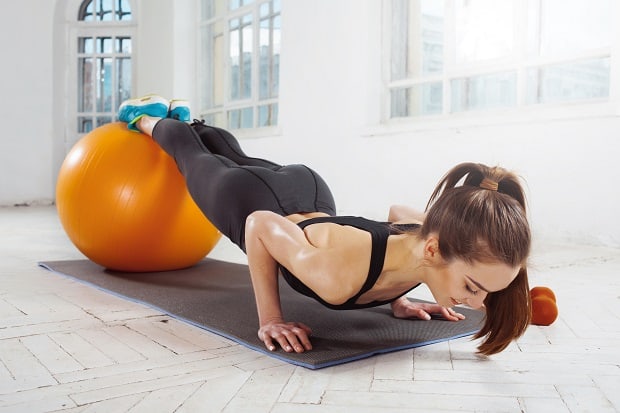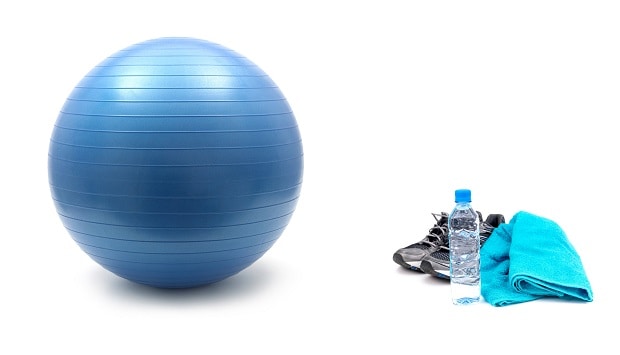Fitball is a large inflatable ball with a diameter of 45-75 cm and is also the name of a group lesson with this projectile. The peak of the popularity of this equipment came in the late nineties – early two thousandths. Then the “Swiss ball” was a real trend, they came up with a lot of aerobic lessons, they tried to implement it in all strength programs. Now the hype has subsided, and athletes often just take the ball when they want to shake the press or do reverse hyperextension.
In the format of an aerobic lesson, fitball is a sports and entertainment action with jumps, swings and a bunch of different fun activities.
What is a fitball for?
Fitness cynics say that all such equipment and group classes are needed only for one thing – to attract a not very strong-willed person to training, make him pay money and entertain him for an hour so that he does not lose focus and move at least somehow- someday.
In fact, fitball is useful for:
- rehabilitation of knee and hip joints using exercise therapy;
- relieving the load on the spine when doing ab exercises;
- increased joint mobility after surgery or injury;
- reducing the axial load on the ODA (musculoskeletal system) during jumping.
Only we are broadcast something completely different. The fitness ball purportedly helps to target the deep layers of muscle and thereby improve metabolism, helping to burn fat. Is it so? It strongly depends on what to do with this ball. If the whole workout comes down to sitting jumping and rolling the projectile under your own heel, you don’t need to wait for special results. Most likely, you will not achieve “fat burning” at all, especially if you do not follow a competent diet.
But if the fitball is used as a projectile that allows you to supplement a balanced fitness program, and its owner also eats normally, everything will be fine with fat. He will go away. So it all depends not on the choice of fitness lessons and equipment, but on how rich the training session is with the right things, for example, squats, deadlifts and bench presses. Yes, at the end of the lesson it is quite possible to twist on the ball and do reverse hyperextension.
Types of fitballs
There are quite a few types of fitness balls, although this is basic equipment:
- Variation in size – there are balls from 45 cm to 75 cm in diameter, if we take a sports mass market. For specialized purposes, such as training basketball players, there may be larger shells.
- By type of coating – a standard rubberized and non-slip ball. There are also sleek options that, in fact, are intended for aquafitness, but in domestic clubs they can also be found in the halls.
- By the level of impact – conventional and with massage attachments. The latter are used for both fitness and MPF (myofascial release).
- By appointment – children’s playground and fitness. The former may be with handles in an interesting design, but they are not intended for adult training.
How to choose the right size ball?
Matching the ball by size is pretty straightforward. You need to stand up, bend your leg at the knee joint and bring your hip parallel to the floor. The ball must fit exactly under the thigh and must not be the same height as the top of the leg.
For fans of numbers and statistics, there is also a sign with the height of the people involved and the diameter of the fitball:
| Ball diameter | Athlete’s height |
| 65 cm | 150-170 cm |
| 75 cm | 170-190 cm |
Balls 45 cm in diameter are intended for children.
Benefits of gymnastic ball exercises
Exercises on this ball have both advantages and disadvantages. The pros are:
- the ball is soft, during twisting it is impossible to injure the back;
- it is unstable and helps to include more different small muscles during training;
- it is easy to buy it at home or in any minimalistic room and even for work;
- it is comfortable to sit on during normal work;
- sometimes he can replace the bench;
- fitball is suitable for training older people and pregnant women;
- it can be used to stretch the muscles of the back for those who cannot do it in the usual way;
- the shell helps to diversify the workouts and make them fun.
We can immediately say that the fitball does not have any magic power. Yes, exercises with him are a little more difficult than gymnastics on the floor or just with your own body weight. When training on the ball, a person receives an unstable projectile that must be balanced before the exercise can be performed. That’s why the fitball works.
What is a group fitball lesson? This is a regular cardio that aims to burn fat, increase calorie expenditure, strengthen the heart, and combat physical inactivity. It has no advantages over other similar activities.
Important: No comparisons have been made as to how much fitnessball boosts metabolism. But there is research showing that abdominal exercises are more effective on a fitball than on the floor.
Thus, for an ordinary visitor of the gym who can perform classical strength exercises with a barbell and dumbbells, the ball will be useful only for performing twisting, forward and reverse hyperextension and, possibly, the “Swiss knife”. All this exercises for the press and core.
Who is contraindicated to play fitball?
Some exercise with balls includes children’s fitness, workouts for pregnant women and classes for older people. It is not worth saying that the projectile is contraindicated in itself. Certain exercises may not be suitable for injuries and joint function.
In particular:
- It is not recommended to make a gluteal bridge supported by a fitball in case of unstable hip joints, their trauma or recovery processes after implantation.
- Twisting should be avoided for hernias and protrusions in the “active” phase, when there is pain. As the spine is being rehabilitated, exercises can be included in the program if approved by the exercise therapy doctor.
- Push-ups with toe support on the fitball should not be performed for injuries of the knees, hip joints and shoulders.
- It is better to refuse extensions for unstable ankles, as this exercise requires good support.
There are a lot of misconceptions on the Internet about training pregnant women on fitball. The ball is not necessary for training, moreover, if a woman is accustomed to conventional strength training, it is better for her to continue to perform them in a lightweight version. Exercises from a prone position from the second trimester are excluded, as well as anything that can exert direct pressure on the abdomen and compression on the pelvic organs. In fact, there are exercises in block simulators and various movements with microweights on the arms and legs.
By all means sit down on the fitball in the hope that only it will relieve back pain is not worth it. They are more likely to be relieved by the usual block traction with a small weight.

A little about exercise
A fairly complete gymnastic workout can be done on fitball:
- Warm up – jumping while sitting on the ball. You just need to sit on the fitball with your buttocks and spring up while jumping. This can be supplemented with an articular warm-up and a dynamic part with some aerobic steps, for example, side steps, and swinging the ball from side to side.
- Legs – squats against the wall. The ball – under the lower back, rest it against the wall, perform squats until the hips are parallel to the floor and linger slightly at the bottom point.
- Back . Direct hyperextension is the simplest exercise on the ball. You need to lie on it with your stomach, fix your feet against the wall and unbend your back up, and then gently lower down.
Reverse hyperextension is when lying face down on a bench, they raise the ball with their feet to the level of the body and lower it. - Arms, chest and shoulders. The simplest is to squeeze the ball between the hands while standing, combining it with some kind of walking.
You can also do push-ups from the ball, either by placing it against the wall and resting your palms on it, or putting your feet on it.
Press. Normal twisting, that is, you need to lie with your back on the ball and stretch your lower ribs to the pelvic bones. You can also raise straight legs in a supine position with a fitball clamped between them.
In addition, they also make a “Swiss knife”, that is, pulling the knees to the chest, with the legs resting on the fitball, and hands – in the floor
For oblique abdominal muscles, you can do twisting, lying on the ball on your side.
Fitball gym exercises can be performed 10-20 repetitions, one after the other, creating a circuit workout, or simply done in the usual style, breaking the workout into sets. Such exercises will give general tone and help you get started.
Should you do bench presses and shoulder exercises while sitting on a fitball? Experts were divided. Open any magazine like Shape, and there will be a thousand and one such workouts. TV presenter, blogger and author of fitness manuals Denis Semenikhin, in his book, gives half of the usual chest presses on a fitball. True, he addresses this, for some reason, only to girls, inviting the guys to practice in the usual style.
Rachel Cosgrove, a women’s trainer and rehabilitation therapist from the United States, writes that it is better to start learning how to work with heavy weights without a fitball. And it is worth climbing on them only to shake the press. There is no particular sense in exercises on the arms, shoulders and chest while sitting on the ball.
In general, how to use this training equipment, everyone decides, depending on the goals and sports form. And balls can be invaluable in rehabilitation and pumping up the press.


